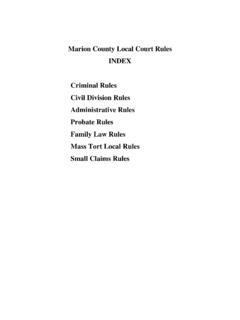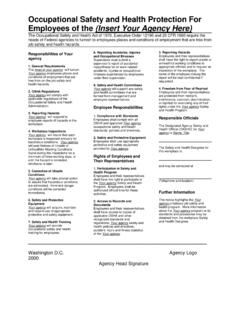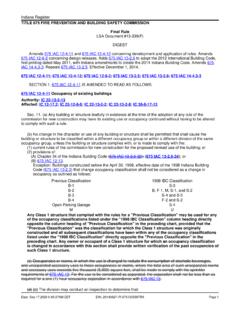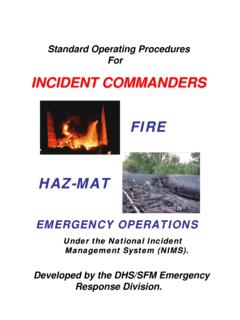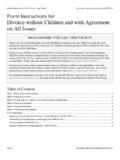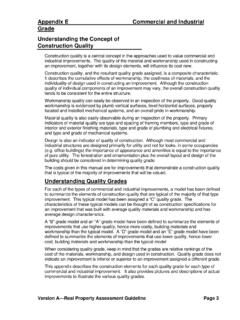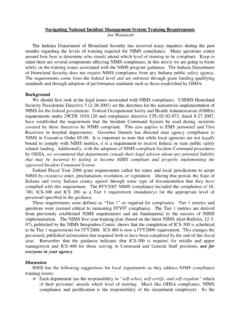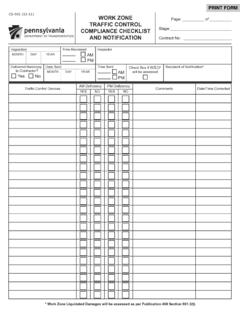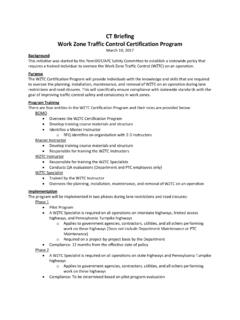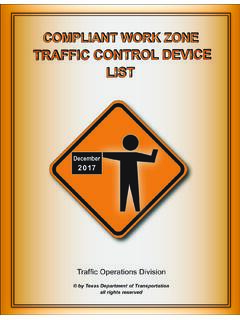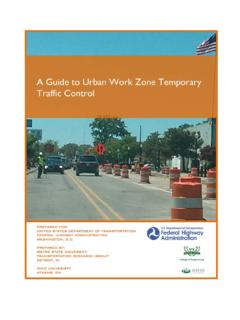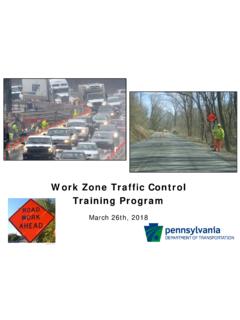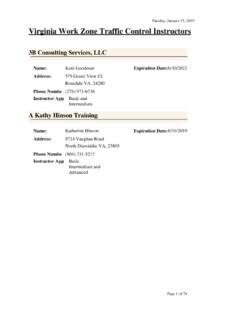Transcription of Work Zone Safety - in.gov
1 INDOTI ndiana Department of TransportationDriving Indiana's Economic GrowthWork Zone SafetyGuidelines for Construction, TrafficMaintenance, and Utility OperationsNovember 2006 Table of Contents Introduction 1 traffic control Devices 1 Signs 1 Channelizing Devices 5 Warning Lights 7 Arrow Displays 8 Pavement Markings 9 Fundamental Principles 9 Parts of a traffic control Zone 10 Taper Length Criteria for work zones 11 Buffer Lengths 12 Supervisor s Checklist 12 Planning the Layout 13 Duration of work 13 Location of work 13 What traffic control Setup Should I Use?
2 14 Curvy and Hilly Locations 14 Night Time traffic control 15 Typical Application Diagrams 17 Definitions of Terms 18 Short Term Stationary (1 to 12 hours) work off the Traveled Lanes 19 work on Paved Shoulders or Parking Lanes 20 Paved Shoulder Closed on Divided Roadway 21 Lane Closure on a Two-Lane Road 22 Center Turn Lane Closed 23 Lane Shift on a 3-Lane, 2-Way Road 24 Lane Closure on a 4-Lane Undivided Road 25 Lane Closure on Divided Roadway or 1-Way Street 26 Double Lane Closure on Divided Roadway 27 Half Road Closure on Multilane Roadway 28-29 Mainline Right Lane Closed, Entrance Ramp Open 30 Mainline Left Lane Closed, Entrance Ramp Open 31 Mainline Right Lane Closed.
3 Exit Ramp Open 32 work in Vicinity of Exit Ramp 33-34 Partial Ramp Closure 35 Partial Ramp Closure work in Gore Area 36 Lane Closure in Advance of an Intersection work Area on the Through Road 37 work Area on the Side Road 38 Lane Closure Beyond an Intersection work Area on the Through Road 39 work Area on the Side Road 40-41 Lane Closure at a Multilane Intersection 42 Turn Lane Closure at an Intersection 43 Lane Closure on Far Side of Intersection 44 Closure in Center of Intersection 45 Short Duration (up to 1 hour) work off the Traveled Lanes 46 work on Paved Shoulders or Parking Lane 47 work on Paved Shoulder Closed on Divided Roadway 48 Lane Closure on Divided Roadway or One Way Street 49 Lane Closure on a Two-Lane Road 50 Temporary Road Closure 51 Lane Closure in Advance of an Intersection work Area on the Through Road 52 work Area on the Side Road 53 Lane Closure Beyond an Intersection work Area on the Through Road 54 work Area on the Side Road 55 Lane Closure at Side of Intersection 56 Closure in Center of Intersection 57 Lane Closure at
4 A Multilane Intersection 58 Turn Lane Closure at an Intersection 59 Partial Ramp Closure 60 Partial Ramp Closure work in Gore Area 61 Mobile Operations (15 minutes or less)Mobile Operations 62On Paved Shoulder for all Roads 63-64On a Two-Lane Road 65-66On a Two-Lane Road Using Flaggers 67On a Two-Lane Divided Road 68On a Multi-Lane Divided Road 69-70 Pedestrian and Worker Safety 71 Sidewalk Closure Pedestrian Detour 72 Sidewalk Closure Pedestrian Walkway Provided 73 Flagging Procedures 74 Acknowledgments 75 Quick Reference Guide 761 IntroductionThe purpose of this handbook is to present guidelines for work zone traffic control and to supplement basic work zone Safety training.
5 This handbook covers the basic requirements of Part VI of the Manual on Uniform traffic control Devices (MUTCD) with particular emphasis on short term work sites. These requirements apply to construction, maintenance, traf-fic, and utility work handbook presents information and gives examples of typical traffic control applications for two-lane and multi- lane work zones . This information is intended to illustrate the principles of proper work zone traffic control , but is not a standard. Part VI of the MUTCD and the Indiana MUTCD Supplement contain the standards for work zone traffic traffic control diagrams provide minimum require-ments, additional traffic control or protection can be added.
6 This manual covers work setups as presented in the INDOT maintenence/ traffic management Management SituationsThe immediate response to an emergency situation must by necessity make use of available devices and equipment. Given the opportunity, however, longer term emergencies should be treated in a manner similar to other temporary traffic control work control DevicesThe following types of traffic control devices are used in work zone traffic control : Signs Channelizing Devices Warning Lights Arrow Displays Pavement MarkingsSignsSigns used in work zone traffic control are classified as regulatory, guide, or warning.
7 Regulatory signs impose legal restrictions and may not be used without permission from the authority with jurisdiction over the roadway. Guide signs commonly show destinations, directions, and distances. Warning signs give notice of conditions along the Signs Construction, maintenance, traffic and util-ity warning signs are used extensively in street and highway work zones . These signs are normally diamond shaped, having a black symbol or message on an orange background. As a general rule, these signs are located on the right-hand side of the street or highway.
8 Normally, the first advance warning sign used is the road work ahead sign. The util-ity work ahead or workers sign may be substituted where appropriate. Where signs are used to indicate the end of the work zone, the end road work or end utility work sign may be used as The standard size for advance warning signs in work zones is generally 48 inches by 48 inches. Where speeds and volumes are moderately low, a minimum size of 36 inches by 36 inches may be used (see Part VI of the MUTCD for specific sign sizes). Sign sizes in contract plans or other agency documents may exceed MUTCD minimum requirements and shall be Standards for height and lateral clearance of roadside signs are included in Part VI of the MUTCD.
9 Temporary post-mounted signs should be mounted at a height of at least 7 feet, measured from the bottom of the sign. Signs mounted on Type III barricades which close any part of a road or lane should not cover more than 50 percent of the top two rails or 33 percent of the total area of the three rails. Signs mounted on other portable supports or barricades used solely as a sign support may be at lower heights, but the bottom of the sign shall be not less than one foot above the traveled Spacing (feet) 25-30 35-40 45-55 Multilane Divided Expressway/ mph mph m ph 50 mph or higher Freeway A 100 350 500 1,000 1,000 B 100 350 500 1,600 1,600 C 100 350 500 2,640 2,640 Distances shown are approximate.
10 Sign spacing should be adjusted for curves, hills, intersections, driveways, etc., to improve sign of Advance Warning Signs2aNotes:1. Signs should be called for when traffic will travel through an active construction zone marked by ROAD work Signs are not required for the following types of activities:Where the active construction zone is completely iso-lated from traffic ( a full road closure with detour or construction along a new duration operations (those lasting less than 1 hr.)Operations that will not encroach upon the pavementEdgeline and centerline painting A single sign should be called for in advance of the first ROAD work AHEAD sign for each direction of travel on the mainline(s))



